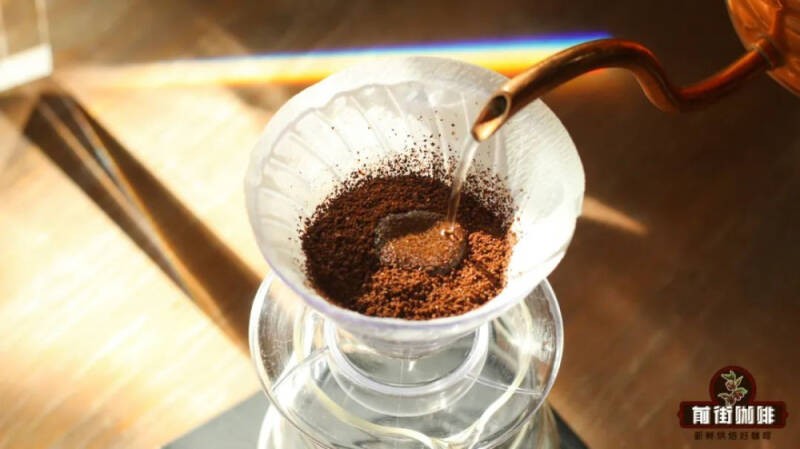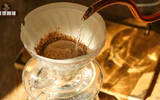Does it take 30 seconds to steam hand-brewed coffee? How is the carbon dioxide content of coffee affected?
There are many ways to brew coffee by hand, but it can be said that most of the brewing process is mainly divided into two steps: steaming and extraction.

Although it is also the act of using hot water to extract coffee powder, steaming is more like a preparatory step for hand flushing. By wetting the coffee powder with a small amount of hot water, carbon dioxide is released from the coffee powder, and capillarity is used to "connect" the coffee powder to the coffee powder, so that the subsequent injection of hot water can not only have a more efficient extraction, but also distribute more evenly. So we can know that the steaming step is very important for the production of hand-brewed coffee. But "since ancient times", most coffee people are used to steaming for a traditional time: 30 seconds. As everyone knows, not all coffee beans need to be steamed for 30 seconds. Of course, Qianjie is not saying that this time is wrong, but if we want to make more delicious hand-brewed coffee, we can't be limited to a fixed formula. Beans will change according to their own state, and have different requirements for steaming time, only with the right time, we can make better hand-made coffee! Therefore, in order to make better hand-made coffee, we need to do "perfect steaming" first! And the first step to perfect steaming is to know how to determine the end time of steaming!

How to determine the end time of steaming? After all, the main function of steaming is to remove carbon dioxide from coffee beans and reduce the impact on the extraction of subsequent hot water. So we need to make a decision according to the "gas content" of the coffee bean itself. When the coffee beans contain more carbon dioxide, we need to prolong the steaming time appropriately to make the coffee beans emit more gas. Generally speaking, on the basis of the steaming time of 30 seconds, it can be increased by about 5 seconds and 10 seconds. There are two main types of coffee beans that need to prolong the steaming time: freshly roasted coffee beans during the breeding period, because they are too fresh, they do not have enough time to discharge the carbon dioxide "filled" in the baking process, so when cooking, we need to prolong the steaming time appropriately.
The second is the high-density coffee beans (shallow roasting), because the expansion rate of the coffee beans is not high, so there are not many gaps for carbon dioxide flow, which means that the exhaust speed will be slowed down. Therefore, although their carbon dioxide content is not high, it takes longer to discharge the carbon dioxide that affects the extraction, whether it is the bean cultivation time or the steaming time, which needs to be relatively prolonged. When there is not so much carbon dioxide in coffee beans, we do not need to waste too much time on steaming, so at this time we can appropriately reduce the steaming time and shorten the extraction time (5-10 seconds). They are:
Beans that are too long away from baking have plenty of exhaust time when they are placed, so there is little carbon dioxide left in the body during cooking, so it does not need too long of steaming to exhaust. The second is the deep-roasted coffee beans, although they have experienced a longer baking process resulting in more carbon dioxide, but because their expansion rate will be higher, so they will be more "sensitive". As soon as it comes into contact with hot water, carbon dioxide will pop out in one breath, and after the bean cultivation period, it does not need too much steaming time to exhaust!
But sometimes, the information can not be seen before cooking! Therefore, we still have to determine the time according to the state of the powder layer during steaming. So, the first thing to do is to moisten the coffee powder bed evenly, which is also the second point of perfect steaming! If the coffee powder bed can not be evenly moistened, then steaming this step also misses its main significance. So how do you wet all the coffee powder evenly with a small amount of hot water? It is very simple to distribute hot water according to the distribution of coffee powder. If you are using a tapered filter cup, you can focus on the center injection of a small amount of hot water for steaming, for example: in the form of a circle, extend the injection from the middle to the outer ring with minimal water flow, but stay in the center for more time / inject more water!
Or you can draw a circle from the outside to the inside, anyway, the main center of gravity of water injection, it is best to focus on the center of coffee powder accumulation! The trapezoidal filter cup is the same, but if it is a cake / flat bottom filter cup, then we just need to keep the powder bed flat and inject water evenly in the form of a circle. When the water moistens the powder bed evenly, we will observe the exhaust state of the powder bed! There are two places to observe, one is the wettability of the powder bed, and the other is the exhalation frequency of the powder bed. If we see that the powder bed has dried up and no fresh bubbles appear before the steaming time reaches 30 seconds, then it means that there is not much carbon dioxide left in this coffee bean, so we no longer need to continue steaming, so we can start the next stage of water injection.
And if after 30 seconds, the powder bed is still wet and bubbles continue to emerge, then it means that there is still a lot of carbon dioxide in the coffee powder. At this time, we can appropriately increase the time of steaming. Let the powder bed discharge more "obstacles" ~ so, we can know that as long as the steaming time adapts to the current state of beans, then we can make the subsequent extraction more extreme. It is not too much to say that it is perfect and steamy.
-END-
Important Notice :
前街咖啡 FrontStreet Coffee has moved to new addredd:
FrontStreet Coffee Address: 315,Donghua East Road,GuangZhou
Tel:020 38364473
- Prev

50 homes have been evacuated! Boutique coffee brand Seesaw has been exposed to close in large numbers again!
▲ Click to pay attention| Since the Daily Boutique Coffee Culture Magazine Coffee Factory was exposed at the end of last year that many stores across the country were closed, six months later, coffee brand Seesaw Coffee (referred to as "Seesaw") once again reported that the number of stores has shrunk significantly. nearly
- Next

How to calculate the extraction time of coffee? Should the espresso extraction timing be when the coffee maker is started or when it is discharged?
Whether it's Italian style or hand punch, the problem of measuring time will always trouble some friends. For example, when making hand-brewed coffee, should the time be calculated before steaming and filling, or should it be after filling? Or, when extracting and concentrating, should the time be calculated before pressing to start extracting, or should it be after the coffee is discharged?
Related
- What effect does Italian American coffee with filter paper have? Will coffee taste better if it is put on filter paper at the bottom of the powder bowl?
- What is the color difference in coffee beans? What are the characteristics of honey processed coffee beans? Why are the anaerobically treated coffee beans uneven in color?
- How does novice Xiaobai quickly get started and make coffee? Newbies learn to make coffee by hand and share the specific steps and process process!
- Costa tea has a shelf life of 100 years?! Expert: Unable to verify
- It's a huge uproar! American milk addition was rejected by Manner employees?!
- Mocha pot coffee bean recommendations| How fine and how much powder should be used for grinding? What parameter ratios do I need to use to make milk with Mocha pot coffee?
- What are the characteristics of the world's top ten coffee beans treated with Costa Rica honey? How to make black honey kadura from Tarazhu Pilon Processing Plant taste good?
- How to make deep-roasted coffee? What grinding water temperature does authentic Jamaica Blue Mountain No. 1 coffee use to brew it well?
- Selected high-grade rose summer coffee flavor tasting guide Why Panama rose summer has the aroma of flowers and fruits
- What equipment does a novice Xiaobai need to buy to learn to make coffee? Filter cup electronic scale bean grinder manual flushing pot purchase guide

